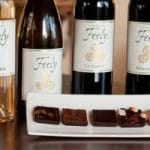To assess the food matching potential you need an idea of the relative level of each of the five main components of a wine: alcohol, acids, tannins / colour, sugar, and natural flavours / aromas including elements like oak used in wine-making. The weight is directly affected by these components particularly alcohol, acidity and sugar. The higher the alcohol the weightier the wine, the higher the acidity the lighter the wine and the higher the sugar the heavier the wine.
Heavier wine goes with heavier food and lighter wine with lighter food but heavy and heavy can be too much thus having the offset of good acidity on a higher alcohol wine can provide the relief needed.
Alcohol creates a sensation of sweetness. It produces a warmth – or burning if very high – on the back of the throat. You can look at the level of alcohol on the bottle but you should be able to assess from taste and sensation between high, medium and low.
Acidity provides backbone and structure to a wine giving sensations of freshness and crispness. The two primary acids in wine are tartric acid and malic acid. In most red wines and some white wines the ‘green apple’ malic acid is converted to a softer, more buttery, lactic acid by malolactic fermentation. Whether a wine has done its malo – malolactic fermentation – or not, has a major impact on its overall character and what it matches with.
Acidity decreases the weight and richness of a wine and provides a lift. A wine’s acidity decreases naturally with time and a good level of acidity helps a wine to age gracefully and retain its youth.
Acidity is naturally higher in organic and biodynamic wines because we do not use chemical fertilisers (read about why organic wine is better here). This natural acidity is part of the overall harmony of a wine and allows us to use lower levels of sulphur dioxide in our wines as acid acts as a natural preservative.
When you taste a wine you will find the level of acidity with the sensors in the back of your cheeks and sides of the back half of your tongue. Acidic wines make your mouth water.
You can learn more about wine with one of our wine courses Wine Courses in France or a gourmet wine tour
Read more about food pairing in our pairing series starting with part 1
You can also learn more about wine with Caro’s book Wine The Essential Guide and read about the story of our organic farm the series includes three books Grape Expectations; Saving our Skins and Glass Half Full by Caro Feely.
Join our mailing list to receive our seasonal newsletter, events, wine pairing, recipes and more info on this topic









